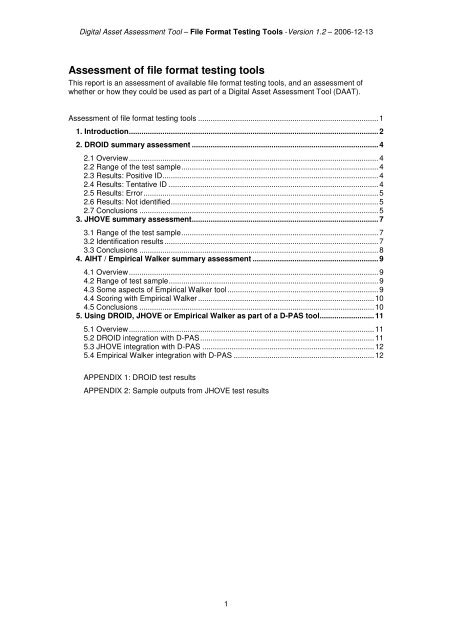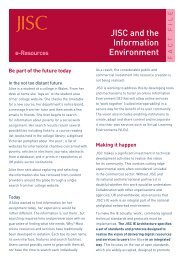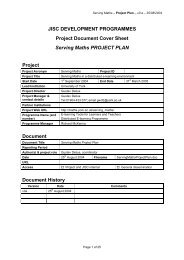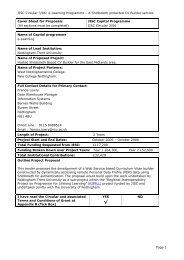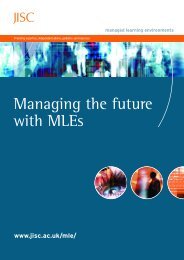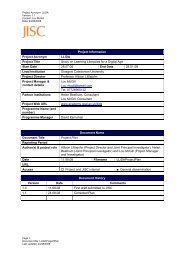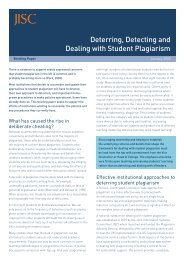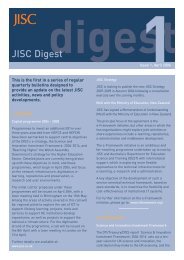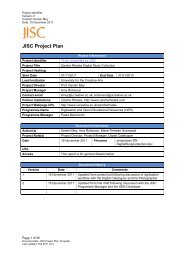Assessment of file format testing tools - Jisc
Assessment of file format testing tools - Jisc
Assessment of file format testing tools - Jisc
You also want an ePaper? Increase the reach of your titles
YUMPU automatically turns print PDFs into web optimized ePapers that Google loves.
Digital Asset <strong>Assessment</strong> Tool – File Format Testing Tools -Version 1.2 – 2006-12-13<br />
<strong>Assessment</strong> <strong>of</strong> <strong>file</strong> <strong>format</strong> <strong>testing</strong> <strong>tools</strong><br />
This report is an assessment <strong>of</strong> available <strong>file</strong> <strong>format</strong> <strong>testing</strong> <strong>tools</strong>, and an assessment <strong>of</strong><br />
whether or how they could be used as part <strong>of</strong> a Digital Asset <strong>Assessment</strong> Tool (DAAT).<br />
<strong>Assessment</strong> <strong>of</strong> <strong>file</strong> <strong>format</strong> <strong>testing</strong> <strong>tools</strong> ......................................................................................1<br />
1. Introduction.......................................................................................................................2<br />
2. DROID summary assessment .........................................................................................4<br />
2.1 Overview.......................................................................................................................4<br />
2.2 Range <strong>of</strong> the test sample..............................................................................................4<br />
2.3 Results: Positive ID.......................................................................................................4<br />
2.4 Results: Tentative ID ....................................................................................................4<br />
2.5 Results: Error................................................................................................................5<br />
2.6 Results: Not identified...................................................................................................5<br />
2.7 Conclusions ..................................................................................................................5<br />
3. JHOVE summary assessment.........................................................................................7<br />
3.1 Range <strong>of</strong> the test sample..............................................................................................7<br />
3.2 Identification results......................................................................................................7<br />
3.3 Conclusions ..................................................................................................................8<br />
4. AIHT / Empirical Walker summary assessment ............................................................9<br />
4.1 Overview.......................................................................................................................9<br />
4.2 Range <strong>of</strong> test sample....................................................................................................9<br />
4.3 Some aspects <strong>of</strong> Empirical Walker tool........................................................................9<br />
4.4 Scoring with Empirical Walker ....................................................................................10<br />
4.5 Conclusions ................................................................................................................10<br />
5. Using DROID, JHOVE or Empirical Walker as part <strong>of</strong> a D-PAS tool..........................11<br />
5.1 Overview.....................................................................................................................11<br />
5.2 DROID integration with D-PAS...................................................................................11<br />
5.3 JHOVE integration with D-PAS ..................................................................................12<br />
5.4 Empirical Walker integration with D-PAS ...................................................................12<br />
APPENDIX 1: DROID test results<br />
APPENDIX 2: Sample outputs from JHOVE test results<br />
1
Digital Asset <strong>Assessment</strong> Tool – File Format Testing Tools -Version 1.2 – 2006-12-13<br />
1. Introduction<br />
Understanding <strong>file</strong> <strong>format</strong>s is an important part <strong>of</strong> preserving digital assets. The Digital Asset<br />
<strong>Assessment</strong> Tool (DAAT) project aimed to assess three available <strong>tools</strong> and evaluate their<br />
potential usefulness as part <strong>of</strong> the Digital Preservation <strong>Assessment</strong> Survey (D-PAS) tool.<br />
Each tool <strong>of</strong>fered some form <strong>of</strong> automated <strong>file</strong> <strong>format</strong> identification.<br />
The three <strong>tools</strong> evaluated were:<br />
1. DROID (Digital Record Object Identification), a s<strong>of</strong>tware tool developed by The<br />
National Archives to perform automated batch identification <strong>of</strong> <strong>file</strong> <strong>format</strong>s. It is the<br />
first in a planned series <strong>of</strong> <strong>tools</strong> developed by The National Archives under the<br />
umbrella <strong>of</strong> its PRONOM 1 technical registry service.<br />
(http://droid.sourceforge.net/wiki/index.php/Introduction)<br />
2. JHOVE - JSTOR/Harvard Object Validation Environment. JSTOR 2 and the Harvard<br />
University Library are collaborating on a project to develop an extensible framework<br />
for <strong>format</strong> validation. JHOVE provides functions to perform <strong>format</strong>-specific<br />
identification, validation, and characterization <strong>of</strong> digital objects.<br />
(http://hul.harvard.edu/jhove/)<br />
3. AIHT 3 at Stanford University: Automated Preservation <strong>Assessment</strong> <strong>of</strong><br />
Heterogeneous Digital Collections, and the Empirical Walker tool.<br />
(http://www.dlib.org/dlib/december05/johnson/12johnson.html)<br />
Within the DAAT project, our aim was not to make a general report on whether DROID or<br />
JHOVE work at all, but whether they have useful qualities which will help us identify the<br />
preservation needs <strong>of</strong> our assets.<br />
The following outline shows the scope <strong>of</strong> these tests:<br />
Object: to assess the usefulness and viability <strong>of</strong> the <strong>file</strong> <strong>format</strong> identification <strong>tools</strong> DROID,<br />
JHOVE and Empirical Walker, within the context <strong>of</strong> the DAAT project.<br />
Outcome: produce a short but detailed technical report on findings, with an intended<br />
audience <strong>of</strong> potential DAAT users. The report should be like a ‘consumer’ report, with<br />
practical guidance and easy-to-understand in<strong>format</strong>ion.<br />
Output:<br />
• A list <strong>of</strong> all <strong>file</strong> <strong>format</strong>s used in the test-bed environments.<br />
• Clearly stated reasons for inclusion <strong>of</strong> <strong>format</strong>s in the tests, especially certain <strong>format</strong>s<br />
which appear to be no more than system <strong>file</strong>s.<br />
• Inclusion <strong>of</strong> some ‘stress-test’ <strong>format</strong>s, such as many different types <strong>of</strong> text <strong>file</strong>s<br />
(plaintext, Unicode, MS-DOS), and observation <strong>of</strong> results.<br />
• Inclusion <strong>of</strong> some complex objects, such as a Word <strong>file</strong> with an embedded video, and<br />
see if any <strong>of</strong> the <strong>tools</strong> manage to identify what’s going on in a way that’s useful to us.<br />
Assumptions made:<br />
• The use <strong>of</strong> commonly known and supported <strong>file</strong> <strong>format</strong>s will affect the preservation <strong>of</strong><br />
an asset – so D-PAS needs to know about <strong>format</strong>s.<br />
• We need to identify <strong>file</strong> <strong>format</strong>s, and validate them too.<br />
• We need some form <strong>of</strong> ‘deep <strong>file</strong>’ characterisation, to identify the significant<br />
characteristics <strong>of</strong> a <strong>format</strong>. Metadata extraction is a significant part <strong>of</strong> this, but not the<br />
only dimension <strong>of</strong> the process.<br />
• In addition to identifying the <strong>file</strong> <strong>format</strong>, we may also need to know the s<strong>of</strong>tware type<br />
used to create it, access it, and preserve it. This isn’t always necessary, though – a<br />
1 PRONOM is an on-line in<strong>format</strong>ion system about data <strong>file</strong> <strong>format</strong>s and their supporting s<strong>of</strong>tware products. See<br />
http://www.nationalarchives.gov.uk/pronom/.<br />
2 JSTOR: Journal Storage, The Scholarly Journal Archive. See http://www.jstor.org/.<br />
3 AIHT: The Archive Ingest and Handling Test, a project devised and funded by the Library <strong>of</strong> Congress.<br />
2
Digital Asset <strong>Assessment</strong> Tool – File Format Testing Tools -Version 1.2 – 2006-12-13<br />
huge number <strong>of</strong> <strong>tools</strong> are capable <strong>of</strong> creating and accessing plain text <strong>file</strong>s, for<br />
instance and it’s rarely helpful to know exactly which one was used. In fact, many<br />
different <strong>tools</strong> can be used to create a particular digital object.<br />
• Ideally, we’d like to see each digital asset in the context <strong>of</strong> the in<strong>format</strong>ion<br />
environment that supports it – for example pathnames, dates <strong>of</strong> access, dates <strong>of</strong><br />
modification, creator names, etc.<br />
• Other things the D-PAS tool may need to consider are <strong>tools</strong> for virus checking and<br />
fixity checking, but probably not in the context <strong>of</strong> this task.<br />
3
Digital Asset <strong>Assessment</strong> Tool – File Format Testing Tools -Version 1.2 – 2006-12-13<br />
2. DROID summary assessment<br />
2.1 Overview<br />
The DAAT project team downloaded a copy <strong>of</strong> DROID and made some experiments with it on<br />
our own drives.<br />
• 77 <strong>file</strong>s were tested in a test environment.<br />
• 29 <strong>file</strong>s were identified by DROID as ‘Positive’.<br />
• 11 <strong>file</strong>s were identified by DROID as ‘Tentative’.<br />
• 3 <strong>file</strong>s were reported by DROID as ‘Error’.<br />
• 34 <strong>file</strong>s (nearly 50% <strong>of</strong> the sample) came back as ‘Not identified’.<br />
2.2 Range <strong>of</strong> the test sample<br />
Besides familiar <strong>format</strong>s like text and image <strong>format</strong>, the sample included a number <strong>of</strong> system<br />
<strong>file</strong>s; <strong>file</strong>s that a digital asset might depend on; complex compound <strong>file</strong>s; and some <strong>file</strong>s<br />
created by Mina Creathorn designed specifically to stress-test DROID and the level <strong>of</strong> detail it<br />
could generate.<br />
2.3 Results: Positive ID<br />
For common MS Office and other popular <strong>format</strong>s, DROID successfully identified (for<br />
example) .PPT as a Powerpoint Presentation, and .PDF as a Portable Document Format.<br />
However, .XLS <strong>file</strong>s were not identified as Excel spreadsheets, but as ‘Binary Interchange File<br />
Format (BIFF) Worksheet’. This is a technically correct description <strong>of</strong> the <strong>file</strong> <strong>format</strong> (as<br />
opposed to the application which created it), as PRONOM’s own in<strong>format</strong>ion on the <strong>format</strong><br />
makes clear. It can be confusing to those unfamiliar with these distinctions, however. Another<br />
.PPT <strong>file</strong> was identified as an ‘OLE2 Compound Document Format’, almost certainly because<br />
it contained other media. This is, again, a correct description <strong>of</strong> the <strong>format</strong>, but it is less than<br />
helpful for assessment or preservation purposes. OLE2 Compound Documents can contain<br />
many different types <strong>of</strong> entity, some <strong>of</strong> which present much greater management challenges<br />
than others.<br />
An .RTF <strong>file</strong> was positively identified as ‘Rich Text Format’, but 7 ‘versions’ <strong>of</strong> the <strong>format</strong> were<br />
<strong>of</strong>fered by DROID as possibilities, with no indication as to which version was more likely to be<br />
correct. (For RTF <strong>file</strong>s which don’t exploit features specific to a given version, all <strong>of</strong> them are<br />
correct, <strong>of</strong> course. But this is also confusing to the uninitiate.) However, for two .DOC <strong>file</strong>s<br />
DROID successfully identified that one was created in MS Word Version 6.0/95 and the other<br />
in V2.<br />
For our two ‘complex’ <strong>file</strong>s, the results were interesting. DROID reported a Word <strong>file</strong><br />
embedded with an .ASF <strong>file</strong> as an ‘OLE2 Compound Document Format’, which presents us<br />
with the same problem <strong>of</strong> unhelpful accuracy which we saw with the powerpoint presentation<br />
above. A Word <strong>file</strong> with a .CSV <strong>file</strong> embedded fared slightly better, similarly identified as a<br />
compound while its csv component was reported as a BIFF worksheet.<br />
Of system <strong>file</strong>s, .EXE, .AX, .SYS, .TLB and .DLL <strong>file</strong>s were identified simply as ‘Windows<br />
Portable Executable’ <strong>format</strong>s. .BAK and .ODC. <strong>file</strong>s were identified as ‘Hypertext Markup<br />
Language’.<br />
2.4 Results: Tentative ID<br />
In all ‘Tentative’ cases, DROID identified a named <strong>format</strong> but nothing else (no version, no<br />
PRONOM ID). Two [different?] .CSV <strong>file</strong>s produced the same result – ‘Comma Separated<br />
Values’.<br />
The results on three text <strong>file</strong>s are interesting in that DROID could not identify any difference<br />
between a plain text <strong>file</strong>, a Unicode text <strong>file</strong>, or an MS-DOS text <strong>file</strong>. In all cases, the same<br />
nine ‘options’ were suggested, all apparently equally valid. This is clearly an area where<br />
DROID is capable <strong>of</strong> improvement, since relatively simple techniques are available to<br />
4
Digital Asset <strong>Assessment</strong> Tool – File Format Testing Tools -Version 1.2 – 2006-12-13<br />
distinguish between these types <strong>of</strong> text <strong>file</strong>. It’s possible, however, that the distinctions are<br />
not, at present, <strong>of</strong> great relevance to DROID’s creators.<br />
2.5 Results: Error<br />
The 3 ‘Error’ <strong>file</strong>s were all zero-length <strong>file</strong>s. The reader’s first reaction may be that we were<br />
perverse in even asking DROID to look at such <strong>file</strong>s, which don’t exactly present great<br />
preservation challenges. But zero-length <strong>file</strong>s, though uninteresting in themselves, are<br />
meaningful parts <strong>of</strong> larger <strong>file</strong> collections and require preserving. It’s unhelpful when<br />
automated <strong>tools</strong> report them as errors, particularly if there is no way to shut that error <strong>of</strong>f (we<br />
haven’t checked if this is, in fact, possible with DROID.)<br />
2.6 Results: Not identified<br />
As noted above, 50% <strong>of</strong> the sample was ‘Not identified’ by DROID. The <strong>file</strong>s which DROID<br />
fails to recognise include many system <strong>file</strong>s. Yet these <strong>file</strong>s may be needed to access and<br />
preserve the digital asset. For example:<br />
.INF <strong>file</strong>s provide the ability to create customized s<strong>of</strong>tware installation instructions, which<br />
include registry entries and destination directories. By pointing to the URLs <strong>of</strong> <strong>file</strong>s to<br />
download, an INF <strong>file</strong> provides instructions that Internet Explorer uses to install s<strong>of</strong>tware<br />
components.<br />
.HLP <strong>file</strong>s may be needed as an option within the asset.<br />
.DLL Dynamically Linked Library <strong>format</strong>. A library which is linked to application programs<br />
when they are loaded or run. All assets would be dependant on these <strong>format</strong> <strong>file</strong>s, especially<br />
audio/video ones. DROID was ‘Positive’ about this, but it simply describes it as a ‘Windows<br />
Portable Executable’ <strong>format</strong>.<br />
2.7 Conclusions<br />
• DROID has in<strong>format</strong>ion on a large range <strong>of</strong> <strong>format</strong>s. It uses internal and external<br />
signatures to identify and report the specific <strong>file</strong> <strong>format</strong> versions <strong>of</strong> digital <strong>file</strong>s.<br />
• The behaviour <strong>of</strong> DROID suggests it only reports on <strong>file</strong> <strong>format</strong>s, and nothing else.<br />
The <strong>file</strong> extension isn't everything (and can be misleading) and .PPT doesn't tell a<br />
user if it's Powerpoint version 2 or Powerpoint version 9, for instance. DROID<br />
sometimes is able to make that distinction for us (when the <strong>file</strong> is self-describing, as<br />
many MS Office binary <strong>format</strong>s are) but not always – as the RTF example<br />
demonstrates.<br />
• It can’t yet make distinctions between variations <strong>of</strong> text <strong>format</strong>s<br />
• It may not tell us anything definite about the s<strong>of</strong>tware used to create or access the<br />
asset (which is PRONOM’s job.)<br />
• The results from DROID can be output in XML, CSV or printer-friendly <strong>format</strong>s.<br />
DROID is basing its analysis on the most up-to-date in<strong>format</strong>ion from PRONOM. The tool<br />
arrives pre-loaded with <strong>format</strong> in<strong>format</strong>ion (which you need to update periodically - you're<br />
always prompted to download the latest signature <strong>file</strong> when you launch the tool), which it then<br />
relays in the form <strong>of</strong> a static table.<br />
The other feature it provides is a traffic light diagnostic; for example, you get a green light if<br />
DROID makes a positive ID <strong>of</strong> your <strong>format</strong>. But a red light, for example, isn't an indication <strong>of</strong><br />
whether the asset is at risk. The traffic lights merely indicate that DROID is working.<br />
Further, DROID may not provide any extra in<strong>format</strong>ion that we can't already obtain by simply<br />
looking at the <strong>file</strong> <strong>format</strong> extension or a directory listing. DROID isn't really looking at the<br />
entire in<strong>format</strong>ion environment (which D-PAS will need to).<br />
See Appendix 1 for a detailed table <strong>of</strong> DROID test results.<br />
5
Digital Asset <strong>Assessment</strong> Tool – File Format Testing Tools -Version 1.2 – 2006-12-13<br />
6
Digital Asset <strong>Assessment</strong> Tool – File Format Testing Tools -Version 1.2 – 2006-12-13<br />
3. JHOVE summary assessment<br />
Soon after we began looking at JHOVE, the Digital Curation Centre published a case study<br />
on JHOVE 4 . This prompted the question whether the DAAT project needed to test JHOVE at<br />
all, as there is already a lot <strong>of</strong> available in<strong>format</strong>ion on its behaviour. However, it was agreed<br />
we need to generate evidence <strong>of</strong> some form <strong>of</strong> experimentation, and even if the results tell us<br />
what we already know, it's still original evidence.<br />
We knew in advance the behaviour <strong>of</strong> JHOVE was going to be limited (in its test state, it only<br />
works on a dozen <strong>file</strong> <strong>format</strong>s anyway), but even so we deemed it useful to run it on test <strong>file</strong><br />
<strong>format</strong>s held in ULCC systems, and make a note <strong>of</strong> observations <strong>of</strong> its behaviour, particularly<br />
in the context <strong>of</strong> the <strong>file</strong>’s importance as an asset.<br />
3.1 Range <strong>of</strong> the test sample<br />
JHOVE is currently capable <strong>of</strong> analysing the following <strong>file</strong> types: AIFF, ASCII, BYSTREAM,<br />
GIF, HTML, JPEG, JPEG2000, PDF, TIFF, UTF8, WAVE and XML. We were therefore limited<br />
as to the range <strong>of</strong> <strong>file</strong>s we could test. The following 12 test <strong>file</strong> <strong>format</strong>s were subjected to<br />
JHOVE analysis:<br />
• .JPEG<br />
• .HTML<br />
• .TBI<br />
• .DLL<br />
• .INC<br />
• .TIFF<br />
• .XML<br />
• .PDF<br />
• .WAV<br />
• .TXT<br />
• .GIF<br />
• .XLS<br />
The TBI and INC <strong>file</strong>s were selected as examples <strong>of</strong> ASCII <strong>format</strong> type. The DLL <strong>file</strong> was<br />
selected as an example <strong>of</strong> BYTESTREAM <strong>format</strong> type.<br />
3.2 Identification results<br />
Result: Well-Formed and Valid<br />
Eight <strong>of</strong> the test <strong>file</strong>s had their <strong>format</strong>s correctly identified by JHOVE and marked as Wellformed<br />
and valid. The main function JHOVE performs is to validate the <strong>format</strong>. The DCC<br />
report puts it like this: "JHOVE reports validation at two levels: (i) wellformed; and (ii) valid. An<br />
object is considered well-formed if all <strong>of</strong> the individual component structures are correct; in<br />
other words, wellformedness is a local property. An object is considered valid if there is<br />
overall consistency between the individual component structures / semantic-level<br />
requirements; in other words, validity is a global property."<br />
JHOVE also determines <strong>format</strong> validation conformance with a third characteristic, ie<br />
consistency. The JHOVE tutorial states “An object is consistent if it is valid and its internally<br />
extracted representation in<strong>format</strong>ion is consistent with externally supplied representation<br />
in<strong>format</strong>ion.”<br />
Result: Not well-formed<br />
Three <strong>of</strong> the test <strong>file</strong>s were reported as ‘Not well-formed’:<br />
The HTML <strong>file</strong> failed and received an ErrorMessage. This was a Lexical error, caused<br />
by bad HTML.<br />
The WAV <strong>file</strong> also received an ErrorMessage stating ‘unexpected end <strong>of</strong> <strong>file</strong>’.<br />
With the TXT <strong>file</strong>, JHOVE encountered an unexpected UTF-16 little-endian encoding<br />
in a UTF-8 <strong>file</strong>.<br />
4 Digital Curation Centre Case Studies and Interviews: JHOVE. Martin Donnelly, HATII, University <strong>of</strong> Glasgow. March<br />
2006. ISSN 1749-8767.<br />
7
Digital Asset <strong>Assessment</strong> Tool – File Format Testing Tools -Version 1.2 – 2006-12-13<br />
3.3 Conclusions<br />
• Unlike DROID, JHOVE works harder to validate that the <strong>file</strong> is what it claims to be,<br />
and picks up things which could present preservation or rendering problems many<br />
years down the line.<br />
• Unlike DROID, it extracts metadata, including properties <strong>of</strong> the <strong>file</strong> such as:<br />
o Date <strong>of</strong> modification<br />
o Size<br />
o Format and version<br />
o Location <strong>of</strong> the asset (in RepresentationIn<strong>format</strong>ion)<br />
o MIMEType<br />
• For image <strong>format</strong>s like TIFF and JPEG, JHOVE also reports on the image metadata<br />
itself, whose integrity could be important. It also reports on embedded metadata in a<br />
PDF.<br />
• JHOVE also creates a lot <strong>of</strong> technical in<strong>format</strong>ion in its outputs whose meaning is not<br />
immediately clear to anyone except perhaps a qualified systems expert. There may<br />
be further explanations provided in the JHOVE literature, but it was not within our<br />
scope to do an exhaustive study <strong>of</strong> all these things, so we don’t know why for<br />
example the analysis <strong>of</strong> the XML <strong>file</strong> created four pages <strong>of</strong> code which JHOVE simply<br />
calls ‘CharacterReferences’.<br />
• JHOVE does not appear to identify s<strong>of</strong>tware. Although it identifies version, for<br />
example PDF Version 1.4, this refers to a <strong>format</strong> version rather than a version <strong>of</strong><br />
s<strong>of</strong>tware used to create or access the asset.<br />
• JHOVE’s major limitation is that at the moment it can only analyse a small number <strong>of</strong><br />
<strong>format</strong>s. How does it behave when asked to analyse a <strong>format</strong> for which it’s not<br />
configured? An MS Excel spreadsheet was included in our test sample; JHOVE<br />
reported it as a BYTESTREAM.<br />
• JHOVE can also do an automated crawl <strong>of</strong> a drive (however we weren’t able to<br />
download the version in DOS that does this).<br />
The results <strong>of</strong> our tests indicate that even in a small sample <strong>of</strong> objects, the tool’s success rate<br />
is very high. The three ‘Not well-formed’ results indicate that JHOVE is doing its job, i.e.<br />
identifying <strong>format</strong> weaknesses in particular <strong>file</strong>s, thus highlighting areas which may require<br />
preservation action. It may be instructive to compare this with DROID, where a ‘Not identified’<br />
result doesn’t indicate there’s anything wrong with the actual <strong>file</strong> <strong>format</strong>; rather, it indicates<br />
that DROID has failed to identify it.<br />
Clearly JHOVE is going to be essential in a digital preservation context (particularly one which<br />
manages to implement the PREMIS 5 model), as it can be used continually to check and<br />
recheck each digital object stored in the repository, and by a process <strong>of</strong> ongoing validation will<br />
give you some clues as to whether you're doing something in your preservation actions which<br />
might affect the validity <strong>of</strong> the asset.<br />
See Appendix 2 for a selection <strong>of</strong> JHOVE test results.<br />
5 PREMIS: PREservation Metadata: Implementation Strategies. For reports <strong>of</strong> the PREMIS working group, see<br />
http://www.oclc.org/research/projects/pmwg/.<br />
8
Digital Asset <strong>Assessment</strong> Tool – File Format Testing Tools -Version 1.2 – 2006-12-13<br />
4. AIHT / Empirical Walker summary assessment<br />
4.1 Overview<br />
This is a project based at Stanford University in the USA, which the DAAT project learned<br />
about in Washington from Keith Johnson (in May 2006). An article about the project was<br />
published in D-Lib magazine December 2005 6 . The AIHT (Archive Ingest and Handling Test)<br />
is a Library <strong>of</strong> Congress project to create a small real-world digital archive, <strong>of</strong> which Stanford<br />
are one <strong>of</strong> the four participating institutions.<br />
Unlike DROID and JHOVE, this is not a separate tool as much as an entire methodology, a<br />
process for automated assessment <strong>of</strong> preservation risk. However, the Stanford team have<br />
evolved an automation tool which is an integral part <strong>of</strong> their process; they call this tool<br />
‘Empirical Walker’.<br />
The D-Lib article describes a fundamentally different approach to that <strong>of</strong> the National<br />
Preservation Office’s L-PAS model. Stanford based their model on workflow, not on static<br />
collections; they devised s<strong>of</strong>tware to analyse large numbers <strong>of</strong> <strong>file</strong> <strong>format</strong>s in a hard drive; and<br />
created an XML output from the process.<br />
They keep stressing in their report that, for best results, analysis <strong>of</strong> <strong>file</strong>s and metadata<br />
extraction had to be automated, not performed manually. They recognised that automation<br />
would allow them to scale the methodology, provide trustworthy data on the collections,<br />
maintain control <strong>of</strong> workflow, and treat a collection as a manageable set <strong>of</strong> objects.<br />
The results <strong>of</strong> the analysis take place within a tight framework <strong>of</strong> pre-determined in<strong>format</strong>ion,<br />
concerning the preservation policy <strong>of</strong> the organisation, and in<strong>format</strong>ion about sets <strong>of</strong> preferred<br />
preservation <strong>format</strong>s. 7 It was tied in an earlier questionnaire form (built by their Technology<br />
<strong>Assessment</strong> Group) which enabled them to evaluate digital objects by classes.<br />
Stanford also made provision for assessing thing like context, meaning, value and importance<br />
<strong>of</strong> assets – through questions directed at the content owner.<br />
So their approach was to build two parallel devices:<br />
1) A mechanism to raise questions about the nature <strong>of</strong> the objects, based on classes<br />
2) A tool to gather in<strong>format</strong>ion about an individual object (or related objects)<br />
At time <strong>of</strong> writing, ULCC do not have a copy <strong>of</strong> the Empirical Walker s<strong>of</strong>tware to assess, so<br />
this assessment is based entirely on the report given by Stanford staff in their D-Lib article.<br />
4.2 Range <strong>of</strong> test sample<br />
Not known for certain, but Table 1 in the D-Lib article indicates a wide range <strong>of</strong> <strong>format</strong>s: Text<br />
<strong>format</strong>s, including ASCII and UTF-8; Image / Graphic <strong>format</strong>s, including JPEG, GIF, TIFF,<br />
BMP, PNG, and Photoshop; MS Office documents, including .DOC, .XLS and .PPT; Audio<br />
<strong>format</strong>s (including WAVE, MP3, and AIFF); Video <strong>format</strong>s, including MPEG, Real, QuickTime<br />
and Windows Media); and possibly more.<br />
4.3 Some aspects <strong>of</strong> Empirical Walker tool<br />
It’s an automated workflow; it surveys a collection automatically.<br />
It describes and assesses a collection <strong>of</strong> digital objects (and judging by published results, can<br />
process large numbers <strong>of</strong> them very quickly).<br />
It drives external assessment <strong>tools</strong> (including JHOVE, which was used as part the Stanford<br />
project).<br />
6 ‘The AIHT at Stanford University’, by Richard Anderson et al. D-Lib Magazine December 2005, Volume 11, Number<br />
12. ISSN 1082-9873.<br />
7 The UK Data Archive also has a table <strong>of</strong> preferred ‘Principal Ingest Formats’ and ‘Preservation Formats’ for the<br />
types <strong>of</strong> data they handle. (See <strong>Assessment</strong> <strong>of</strong> UKDA and TNA compliance with OAIS and METS standards, p 89).<br />
9
Digital Asset <strong>Assessment</strong> Tool – File Format Testing Tools -Version 1.2 – 2006-12-13<br />
It recursively traverses a <strong>file</strong> directory and:<br />
• Associates external metadata with <strong>file</strong>s<br />
• Calculates checksums automatically<br />
• Identifies the <strong>file</strong> <strong>format</strong><br />
• Analyses the <strong>file</strong> content<br />
• Discovers relationships between <strong>file</strong>s<br />
• Builds a METS 8 picture <strong>of</strong> the collection<br />
• Creates structural metadata for the collection<br />
The tool then goes on to create five types <strong>of</strong> ‘Empirical’ metadata – presumably, this means<br />
metadata associated with each individual digital object it finds. These types include things like<br />
fixity and MIME-types. It also uses JHOVE functionality, for example to perform validation.<br />
4.4 Scoring with Empirical Walker<br />
To get results from the tool, you need to load it with the pre-determined in<strong>format</strong>ion about the<br />
organisation and collection, as mentioned above. This includes in<strong>format</strong>ion derived from the<br />
preservation policy; and a <strong>format</strong>-scoring matrix, which was used to help determine preferred<br />
<strong>file</strong> <strong>format</strong>s.<br />
The tool takes all the empirical metadata it has gathered from the directory, and compares it<br />
with the pre-loaded in<strong>format</strong>ion, which enables it to give a score to each individual <strong>file</strong>.<br />
This is probably based on a comparison <strong>of</strong> ‘desired best practice’ for <strong>file</strong>s and <strong>format</strong>s with a<br />
‘snapshot’ <strong>of</strong> what’s actually in the drives. From a sophisticated comparison and calculation<br />
process, it arrives at a tiered scorecard which, when interpreted correctly, enables the<br />
organisation to identify its preservation needs.<br />
Moreover, these results would help identify levels <strong>of</strong> service appropriate to certain classes <strong>of</strong><br />
objects, because Stanford’s extant evaluations had showed them that not all digital objects<br />
are the same, and some <strong>of</strong> them may require a level <strong>of</strong> service over and above simple bit<br />
preservation.<br />
4.5 Conclusions<br />
Empirical Walker, if we can believe the claims made for it, seems to be a far superior tool to<br />
DROID or JHOVE, even though it uses JHOVE for some <strong>of</strong> its results. Our reasons for<br />
assuming this superiority:<br />
• It does more things – like calculating checksums and analysing <strong>file</strong> content<br />
• It understands the whole structure <strong>of</strong> a collection, and relations between <strong>file</strong>s, are<br />
important too (this would appear to be a massive improvement on DROID, which<br />
works exclusively on a <strong>file</strong>-by-<strong>file</strong> basis, regardless <strong>of</strong> context or location)<br />
• It extracts / generates more metadata than either DROID or JHOVE<br />
The Stanford methodology may also be superior to D-PAS, in that:<br />
• It assumes that there is a workflow, not a static collection <strong>of</strong> digital objects<br />
• It integrates the automation <strong>of</strong> the assessment process with questions about the<br />
organisation and institutional policies, and does this more successfully than D-PAS<br />
• It delivers scored results based on the analysis <strong>of</strong> thousands <strong>of</strong> objects (not 400),<br />
compared against fixed matrix systems, which in turn are derived from hard facts<br />
about the nature <strong>of</strong> preferred <strong>file</strong> <strong>format</strong>s and local preservation strategies<br />
8 METS: Metadata Encoding and Transmission Standard. See http://www.loc.gov/standards/mets/.<br />
10
Digital Asset <strong>Assessment</strong> Tool – File Format Testing Tools -Version 1.2 – 2006-12-13<br />
5. Using DROID, JHOVE or Empirical Walker as part <strong>of</strong> a D-<br />
PAS tool<br />
5.1 Overview<br />
In theory, a D-PAS tool might be able to integrate with any <strong>of</strong> these <strong>file</strong> <strong>format</strong> analysis <strong>tools</strong>.<br />
If our project’s hierarchy model proves workable, then a <strong>file</strong> <strong>format</strong> analysis tool could<br />
integrate its results at the level we have determined as 'item'level. In particular, the way the<br />
D-PAS tool is currently built, a tool such as DROID or JHOVE would come into play at our<br />
‘Level 5’, and its results would be applicable to Sections 8-11 <strong>of</strong> the questionnaire.<br />
This assumes that there are two parallel surveys going on: the D-PAS tool collecting the toplevel<br />
pr<strong>of</strong>ile in<strong>format</strong>ion about the organisation and its collections, with the <strong>file</strong> <strong>format</strong> tool<br />
gathering pr<strong>of</strong>ile in<strong>format</strong>ion on individual assets. At some point, the results from a top-down<br />
survey and bottom-up survey would have to find some connectivity to make such an exercise<br />
work.<br />
There are some fields in D-PAS Sections 8-11 where an overlap, if not an exact correlation,<br />
with DROID / JHOVE type in<strong>format</strong>ion can be clearly seen. For example, the following D-PAS<br />
questions from Section 8:<br />
• ‘File <strong>format</strong> type and version’<br />
• ‘Application (and version) used to create the asset’<br />
• ‘Location metadata’<br />
There remains a question as to how to automate the integration <strong>of</strong> the <strong>tools</strong>; whether results<br />
from DROID or JHOVE can be extracted and automatically imported into a D-PAS database,<br />
and have specific scores assigned to the results, thus adding to the final D-PAS score.<br />
The specific D-PAS questions on in Section 10 (File Formats) and Section 11 (S<strong>of</strong>tware) are<br />
slightly more complex. They are asking questions about the stability <strong>of</strong> <strong>format</strong>s, and the<br />
reliability <strong>of</strong> s<strong>of</strong>tware, but phrased in such ways that DROID or JHOVE can’t really answer. If<br />
this integrated approach were to succeed, D-PAS would need a certain amount <strong>of</strong> reworking.<br />
5.2 DROID integration with D-PAS<br />
In terms <strong>of</strong> adding an automated 'crawl and assess'feature to a D-PAS tool, we think DROID<br />
leaves a lot to be desired. DROID will do an automated crawl <strong>of</strong> all <strong>file</strong> <strong>format</strong>s in a drive, but<br />
it will only provide 'static'in<strong>format</strong>ion on its <strong>format</strong>, based on whatever in<strong>format</strong>ion is currently<br />
stored in PRONOM. Importantly, DROID isn't really looking 'inside'a <strong>file</strong>, just reporting on the<br />
extension. To put it bluntly, for all your <strong>file</strong>s which end in .TXT, DROID will tell you exactly the<br />
same thing for all <strong>of</strong> them.<br />
In ULCC’s test, the sample <strong>of</strong> <strong>file</strong>s included ‘non asset’ <strong>file</strong>s with the extensions <strong>of</strong>, for<br />
example, HLP, BAK, INI, EXE. The reason for doing this is that these <strong>file</strong>s may be used to<br />
access and read the digital data. The hardware environment also may be dependent on these<br />
<strong>file</strong>s. If these <strong>file</strong>s are missing or not safe, the asset is at risk. Unfortunately, DROID does not<br />
even recognise any <strong>of</strong> these system <strong>file</strong> types. Wherever possible we have commented on<br />
why we think they ought to be included in any tool used for risk assessment.<br />
DROID does not extract metadata from a <strong>file</strong>. This lack <strong>of</strong> metadata extraction may not be a<br />
problem for D-PAS. Metadata is useful overall for preservation, but it's not particularly<br />
germane to the risk assessment that D-PAS is meant to do. However, it is relevant to a risk<br />
assessment if there is no metadata available at all.<br />
In terms <strong>of</strong> output, DROID is capable <strong>of</strong> generating a .CSV <strong>file</strong>, so the results <strong>of</strong> a DROID<br />
survey could conceivably be integrated with a D-PAS-type database.<br />
11
Digital Asset <strong>Assessment</strong> Tool – File Format Testing Tools -Version 1.2 – 2006-12-13<br />
5.3 JHOVE integration with D-PAS<br />
Again, it seems feasible to run JHOVE on a collection area identified by the D-PAS survey,<br />
and use the results to contribute to the overall D-PAS score.<br />
JHOVE will provide more metadata than DROID, and again some <strong>of</strong> its fields could be used<br />
to identify general or particular <strong>file</strong> <strong>format</strong> risks. For example, even simply counting the<br />
number <strong>of</strong> instances <strong>of</strong> ‘Not well-formed’ or ‘ErrorMessage’ generated by a JHOVE sweep<br />
could provide a useful statistic. This could feasibly be scored in D-PAS.<br />
The JHOVE field ‘RepresentationIn<strong>format</strong>ion’ could also be used in D-PAS to help relocate a<br />
<strong>file</strong> or an asset for further <strong>testing</strong>, although this is not a scoring element.<br />
The ‘LastModified’ field in JHOVE, which is a date field, was considered as something that<br />
might add value to a D-PAS survey. It was decided that this date may not actually be a<br />
meaningful property <strong>of</strong> the <strong>file</strong>; it could equally represent the same value as Created Date.<br />
In short JHOVE does not actually provide any real ‘risk’ metadata, but it does provide some<br />
fields which we could interpret in such ways as to make them contribute towards a risk<br />
assessment survey like D-PAS.<br />
We think export <strong>format</strong>s are possible. The output appears to be structured but we’re not sure<br />
if it is. If we can export, we’d like to find ways to feed the data from certain fields into the D-<br />
PAS database and get them to score.<br />
5.4 Empirical Walker integration with D-PAS<br />
As described above, the Stanford solution is an integrated package <strong>of</strong> which Empirical Walker<br />
is one component. There may be a way to separate out the Empirical Walker tool component<br />
and include it as a step within D-PAS. However:<br />
Empirical Walker is so completely integrated into the Stanford methodology that there<br />
seems to be little point in separating it out.<br />
The Stanford methodology is fundamentally different to D-PAS, meaning the results<br />
from Empirical Walker may not be compatible with D-PAS.<br />
12
File Format <strong>Assessment</strong>: DROID test results<br />
DROID test<br />
My findings so<br />
far<br />
01-Aug-2006<br />
Mina Creathorn<br />
My list includes "non asset" <strong>file</strong>s with the<br />
extensions <strong>of</strong>, for example, .hlp, bak, ini, exe.<br />
My reasons for including these - these <strong>file</strong>s<br />
may be used to access and read the digital<br />
data. The hardware environment also may be<br />
dependent on these <strong>file</strong>s. If these <strong>file</strong>s are not<br />
safe or missing the asset is at risk. DROID<br />
does not recognise many <strong>file</strong> types and<br />
wherever possible I have commented on why<br />
I think they ought to be included in any tool<br />
used for risk assessment. For that matter why<br />
not assess whole systems and platforms?<br />
DROID Version V1.0 SigFile Version<br />
APPENDIX 1<br />
Status File Comments Warning PUID<br />
Not identified C:\DROID\$ncsp$.inf INF <strong>file</strong>s provide the ability to create<br />
customized s<strong>of</strong>tware installation instructions,<br />
which include registry entries and destination<br />
directories. By pointing to the URLs <strong>of</strong> <strong>file</strong>s to<br />
download, an INF <strong>file</strong> provides instructions<br />
that Internet Explorer uses to install your<br />
s<strong>of</strong>tware components.<br />
Not identified C:\DROID\$WinMgmt.CFG Configuration <strong>file</strong>.<br />
Positive C:\DROID\+New SQL Server Connection.odc This connection <strong>file</strong> may be needed for<br />
example to access an sql server database.<br />
fmt/96<br />
Not identified C:\DROID\1.CAT<br />
Positive C:\DROID\1033.MST fmt/111
Status File Comments Warning PUID<br />
Positive C:\DROID\6to4svc.dll Dynamically Linked Library <strong>format</strong>. A library<br />
which is linked to application programs when<br />
they are loaded or run. All assets would be<br />
dependant on these <strong>format</strong> <strong>format</strong> <strong>file</strong>s,<br />
especially audio/video ones.<br />
null<br />
Not identified C:\DROID\85S874.FO_<br />
Not identified C:\DROID\access.hlp This <strong>file</strong> may be needed as an option within<br />
the asset.<br />
Positive C:\DROID\acelpdec.ax null<br />
Not identified C:\DROID\aclui.chm<br />
Positive C:\DROID\acpi.sys null<br />
Positive C:\DROID\activeds.tlb null<br />
Positive C:\DROID\act_rs.png fmt/11<br />
Not identified C:\DROID\adcjavas.inc<br />
Not identified C:\DROID\Address Book.lnk<br />
Not identified C:\DROID\ADMEXS.DL_<br />
Not identified C:\DROID\ADMTOOLW.CH_<br />
Not identified C:\DROID\adojavas.inc<br />
Not identified C:\DROID\ADSUTIL.VB_<br />
Positive C:\DROID\agentsvr.exe null<br />
Not identified C:\DROID\AGT0404.DL_<br />
Tentative C:\DROID\amipro.sam null<br />
Not identified C:\DROID\appstar3.ani<br />
Positive C:\DROID\Argentinien2001.PPT fmt/126<br />
Not identified C:\DROID\ARIAL.TT_<br />
Not identified C:\DROID\ATOMIC.WM_
Status File Comments Warning PUID<br />
Positive C:\DROID\excel.xls fmt/59<br />
fmt/60<br />
fmt/111<br />
Positive C:\DROID\excel4.xls fmt/57<br />
Not identified C:\DROID\FOLDER.ICO<br />
Positive C:\DROID\FreeTaxGuide.pdf fmt/17<br />
Not identified C:\DROID\glob.settings.js<br />
Positive C:\DROID\in the garden.JPG fmt/43<br />
Error C:\DROID\interrupted.lock Zerolength<br />
<strong>file</strong><br />
Positive C:\DROID\londontoexeter.htm fmt/96<br />
Tentative C:\DROID\lotus.wk4 null<br />
null<br />
Positive C:\DROID\MSDE2000A.exe null<br />
Error C:\DROID\MSDOS.SYS Zerolength<br />
<strong>file</strong><br />
Tentative C:\DROID\msdos.txt I created an MS-DOS text <strong>file</strong> but DROID did<br />
not identify it explicitly.<br />
null<br />
null<br />
null
Status File Comments Warning PUID<br />
Positive C:\DROID\P7300969.JPG fmt/41<br />
Positive C:\DROID\powerpnt.ppt fmt/111<br />
Tentative C:\DROID\presenta.shw null<br />
Positive C:\DROID\projects-export.rm.xml fmt/101<br />
Not identified C:\DROID\project_outputs.tbi<br />
Not identified C:\DROID\PUTTY.RND<br />
Not identified C:\DROID\quattro.wb2<br />
Positive C:\DROID\richrtf.rtf fmt/45<br />
fmt/46<br />
fmt/47<br />
fmt/48<br />
fmt/49<br />
fmt/50<br />
fmt/51<br />
Positive C:\DROID\Seal Petition.pdf fmt/18
Status File Comments Warning PUID<br />
null<br />
null<br />
null<br />
null<br />
null<br />
null<br />
null<br />
null<br />
Positive C:\DROID\Un verdadero hijo de puta.asf fmt/132<br />
Tentative C:\DROID\unicodetxt.txt DROID did not identify this as a Unicode text<br />
<strong>file</strong>.<br />
null<br />
null<br />
null<br />
null<br />
null<br />
null<br />
null<br />
null<br />
null<br />
Positive C:\DROID\winword.doc fmt/39<br />
Positive C:\DROID\winword2.doc fmt/38<br />
Tentative C:\DROID\wordpfct.wpd null
Status File Comments Warning PUID<br />
fmt/62<br />
fmt/111<br />
Binary Interchange File<br />
Format (BIFF)<br />
Workbook<br />
OLE2 Compound<br />
Document Format
Digital Asset <strong>Assessment</strong> Tool – File Format <strong>Assessment</strong> Tools -Version 1 – 2006-09-13<br />
File Format <strong>Assessment</strong> APPENDIX 2<br />
Sample outputs from ULCC’s test <strong>of</strong> JHOVE, August 2006<br />
JhoveView (Rel. 1.0, 2005-05-26)<br />
Date: 2006-08-08 14:45:31 BST<br />
RepresentationIn<strong>format</strong>ion: C:\DROID\in the garden.JPG<br />
ReportingModule: JPEG-hul, Rel. 1.1 (2004-12-10)<br />
LastModified: 2006-06-07 10:48:53 BST<br />
Size: 29164<br />
Format: JPEG<br />
Version: 1.01<br />
Status: Well-Formed and valid<br />
SignatureMatches:<br />
JPEG-hul<br />
InfoMessage: Unknown TIFF IFD tag: 41985<br />
Offset: 126<br />
InfoMessage: Unknown TIFF IFD tag: 41986<br />
Offset: 138<br />
InfoMessage: Unknown TIFF IFD tag: 41987<br />
Offset: 150<br />
InfoMessage: Unknown TIFF IFD tag: 41988<br />
Offset: 342<br />
InfoMessage: Unknown TIFF IFD tag: 41989<br />
Offset: 174<br />
InfoMessage: Unknown TIFF IFD tag: 41990<br />
Offset: 186<br />
InfoMessage: Unknown TIFF IFD tag: 41992<br />
Offset: 198<br />
InfoMessage: Unknown TIFF IFD tag: 41993<br />
Offset: 210<br />
InfoMessage: Unknown TIFF IFD tag: 41994<br />
Offset: 222<br />
InfoMessage: Unknown TIFF IFD tag: 50341<br />
Offset: 350<br />
MIMEtype: image/jpeg<br />
Pr<strong>of</strong>ile: JFIF<br />
JPEGMetadata:<br />
CompressionType: Huffman coding, Baseline DCT<br />
Images:<br />
Number: 1<br />
Image:<br />
NisoImageMetadata:<br />
MIMEType: image/jpeg<br />
ByteOrder: big-endian<br />
CompressionScheme: JPEG<br />
ColorSpace: YCbCr<br />
ScannerManufacturer: Asahi Optical Co.,Ltd.<br />
ScannerModelName: PENTAX Optio430RS<br />
SamplingFrequencyUnit: inch<br />
ImageWidth: 360<br />
ImageLength: 480<br />
BitsPerSample: 8, 8, 8<br />
SamplesPerPixel: 3<br />
Scans: 1<br />
QuantizationTables:<br />
QuantizationTable:<br />
Precision: 8-bit<br />
DestinationIdentifier: 0<br />
1
Digital Asset <strong>Assessment</strong> Tool – File Format <strong>Assessment</strong> Tools -Version 1 – 2006-09-13<br />
QuantizationTable:<br />
Precision: 8-bit<br />
DestinationIdentifier: 1<br />
Exif:<br />
ExifVersion: 0220<br />
FlashpixVersion: 0100<br />
ColorSpace: sRGB<br />
ComponentsConfiguration: 1, 2, 3, 0<br />
CompressedBitsPerPixel: 0.77<br />
PixelXDimension: 360<br />
PixelYDimension: 480<br />
DateTimeOriginal: 2006:06:02 10:00:19<br />
DateTimeDigitized: 2006:06:02 10:00:19<br />
ExposureTime: 0.001<br />
FNumber: 3.4<br />
ExposureProgram: unidentified<br />
ExposureBiasValue: 0<br />
MaxApertureValue: 2.6<br />
MeteringMode: pattern<br />
LightSource: unknown<br />
Flash: did not fire, auto mode<br />
FocalLength: 12.6<br />
FocalPlaneResolutionUnit: inches<br />
FileSource: DSC<br />
SceneType: directly photographed image<br />
CustomRendered: normal<br />
FocalLengthIn35mmFilm: 0<br />
SceneCaptureType: standard<br />
Saturation: normal<br />
Sharpness: normal<br />
SubjectDistanceRange: unknown<br />
ApplicationSegments: APP0, APP1<br />
2
Digital Asset <strong>Assessment</strong> Tool – File Format <strong>Assessment</strong> Tools -Version 1 – 2006-09-13<br />
JhoveView (Rel. 1.0, 2005-05-26)<br />
Date: 2006-08-09 16:03:51 BST<br />
RepresentationIn<strong>format</strong>ion: C:\DROID\londontoexeter.htm<br />
ReportingModule: HTML-hul, Rel. 1.1 (2005-04-22)<br />
LastModified: 2006-06-13 14:18:39 BST<br />
Size: 14883<br />
Format: HTML<br />
Status: Not well-formed<br />
ErrorMessage: TokenMgrError: Lexical error at line 1, column 22.<br />
Encountered: "\"" (34), after : ""<br />
MIMEtype: text/html<br />
JhoveView (Rel. 1.0, 2005-05-26)<br />
Date: 2006-08-09 16:14:36 BST<br />
RepresentationIn<strong>format</strong>ion: C:\DROID\excel.xls<br />
ReportingModule: BYTESTREAM, Rel. 1.2 (2005-03-09)<br />
LastModified: 2004-08-04 05:00:00 BST<br />
Size: 5632<br />
Format: bytestream<br />
Status: Well-Formed and valid<br />
MIMEtype: application/octet-stream<br />
Date: 2006-08-09 16:16:36 BST<br />
RepresentationIn<strong>format</strong>ion: C:\DROID\project_outputs.tbi<br />
ReportingModule: ASCII-hul, Rel. 1.1 (2005-01-11)<br />
LastModified: 2006-01-23 16:57:20 GMT<br />
Size: 2236<br />
Format: ASCII<br />
Status: Well-Formed and valid<br />
MIMEtype: text/plain; charset=US-ASCII<br />
ASCIIMetadata:<br />
LineEndings: CRLF<br />
JhoveView (Rel. 1.0, 2005-05-26)<br />
Date: 2006-08-09 16:19:14 BST<br />
RepresentationIn<strong>format</strong>ion: C:\DROID\6to4svc.dll<br />
ReportingModule: BYTESTREAM, Rel. 1.2 (2005-03-09)<br />
LastModified: 2004-08-04 05:00:00 BST<br />
Size: 100352<br />
Format: bytestream<br />
Status: Well-Formed and valid<br />
MIMEtype: application/octet-stream<br />
JhoveView (Rel. 1.0, 2005-05-26)<br />
Date: 2006-08-09 16:22:56 BST<br />
RepresentationIn<strong>format</strong>ion: C:\DROID\adojavas.inc<br />
ReportingModule: ASCII-hul, Rel. 1.1 (2005-01-11)<br />
LastModified: 2004-08-04 05:00:00 BST<br />
Size: 14610<br />
Format: ASCII<br />
Status: Well-Formed and valid<br />
MIMEtype: text/plain; charset=US-ASCII<br />
ASCIIMetadata:<br />
LineEndings: CRLF<br />
3
Digital Asset <strong>Assessment</strong> Tool – File Format <strong>Assessment</strong> Tools -Version 1 – 2006-09-13<br />
JhoveView (Rel. 1.0, 2005-05-26)<br />
Date: 2006-08-09 15:35:14 BST<br />
RepresentationIn<strong>format</strong>ion: C:\DROID\sndrec.wav<br />
ReportingModule: WAVE-hul, Rel. 1.1 (2005-05-13)<br />
LastModified: 2004-08-04 05:00:00 BST<br />
Size: 58<br />
Format: WAVE<br />
Status: Not well-formed<br />
SignatureMatches:<br />
WAVE-hul<br />
ErrorMessage: Unexpected end <strong>of</strong> <strong>file</strong><br />
Offset: 58<br />
MIMEtype: audio/x-wave<br />
JhoveView (Rel. 1.0, 2005-05-26)<br />
Date: 2006-08-09 15:22:40 BST<br />
RepresentationIn<strong>format</strong>ion: C:\DROID\unicodetxt.txt<br />
ReportingModule: UTF8-hul, Rel. 1.1 (2005-01-11)<br />
LastModified: 2006-08-01 14:05:41 BST<br />
Size: 24<br />
Format: UTF-8<br />
Status: Not well-formed<br />
ErrorMessage: UTF-16 little-endian encoding, not UTF-8<br />
MIMEtype: text/plain; charset=UTF-8<br />
4
Digital Asset <strong>Assessment</strong> Tool – File Format <strong>Assessment</strong> Tools -Version 1 – 2006-09-13<br />
JhoveView (Rel. 1.0, 2005-05-26)<br />
Date: 2006-08-08 16:36:28 BST<br />
RepresentationIn<strong>format</strong>ion: C:\DROID\wm3.gif<br />
ReportingModule: GIF-hul, Rel. 1.2 (2005-01-11)<br />
LastModified: 2004-08-04 05:00:00 BST<br />
Size: 6241<br />
Format: GIF<br />
Version: 89a<br />
Status: Well-Formed and valid<br />
SignatureMatches:<br />
GIF-hul<br />
MIMEtype: image/gif<br />
Pr<strong>of</strong>ile: GIF 89a<br />
GIFMetadata:<br />
GraphicRenderingBlocks: 1<br />
Blocks:<br />
LogicalScreenDescriptor:<br />
LogicalScreenWidth: 300<br />
LogicalScreenHeight: 230<br />
ColorResolution: 6<br />
BackgroundColorIndex: 255<br />
PixelAspectRatio: 0<br />
GlobalColorTableFlag: Global color table follows; background<br />
color index meaningful<br />
GlobalColorTableSortFlag: Not ordered<br />
GlobalColorTableSize: 5<br />
GlobalColorTable: 255, 255, 255, 254, 254, 254, 253, 253, 253,<br />
252, 252, 252, 251, 251, 251, 250, 250, 250, 249, 249, 249, 248, 248,<br />
248, 247, 247, 247, 246, 246, 246, 245, 245, 245, 244, 244, 244, 243,<br />
243, 243, 242, 242, 242, 241, 241, 241, 240, 240, 240, 239, 239, 239,<br />
238, 238, 238, 237, 237, 237, 236, 236, 236, 235, 235, 235, 234, 234,<br />
234, 233, 233, 233, 232, 232, 232, 231, 231, 231, 230, 230, 230, 229,<br />
229, 229, 228, 228, 228, 227, 227, 227, 226, 226, 226, 225, 225, 225,<br />
224, 224, 224, 223, 223, 223, 222, 222, 222, 221, 221, 221, 220, 220,<br />
220, 219, 219, 219, 218, 218, 218, 217, 217, 217, 216, 216, 216, 215,<br />
215, 215, 214, 214, 214, 213, 213, 213, 212, 212, 212, 211, 211, 211,<br />
210, 210, 210, 209, 209, 209, 208, 208, 208, 207, 207, 207, 0, 0, 0,<br />
0, 0, 0, 0, 0, 0, 0, 0, 0, 0, 0, 0, 0, 0, 0, 0, 0, 0, 0, 0, 0, 0, 0,<br />
0, 0, 0, 0, 0, 0, 0, 0, 0, 0, 0, 0, 0, 0, 0, 0, 0, 0, 0<br />
ImageDescriptor:<br />
ImageLeftPosition: 0<br />
ImageTopPosition: 0<br />
InterlaceFlag: Image is interlaced<br />
LocalColorTableFlag: No local color table; use global table if<br />
available<br />
LocalColorTableSortFlag: Not ordered<br />
LocalColorTableSize: 0<br />
NisoImageMetadata:<br />
MIMEType: image/gif<br />
ByteOrder: little-endian<br />
CompressionScheme: LZW<br />
ColorSpace: palette color<br />
Orientation: normal<br />
ImageWidth: 300<br />
ImageLength: 230<br />
BitsPerSample: 8<br />
5


